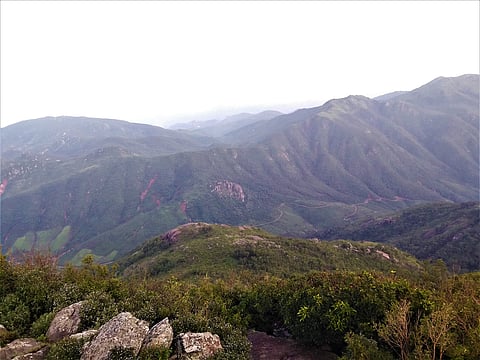

Environmentalists warn of unchecked tourism projects in Odisha’s Mahendragiri hills
Fragile ecosystem houses over 1,300 plant and nearly 400 animal species
Area declared a Biodiversity Heritage Site in 2022, but pressures mount
New cottages, temples and corridors threaten forest and wildlife
Activists call for urgent declaration of the hills as a biosphere reserve
An environmental organisation has raised alarm over large-scale construction in the Mahendragiri hills of Gajapati district, Odisha, warning of severe impacts on the fragile ecosystem and the loss of its rich biodiversity.
Perched more than 1,500 metres above sea level, the Mahendragiri range was declared a Biodiversity Heritage Site in 2022. The fragile hills are home to the Saora (Saura) and Kondh tribes and support 1,348 species of plants and 388 species of animals, many of them endemic and threatened. The site also attracts pilgrims to its Panchpandava temples.
The Odisha government designated 4,250 hectares of forest, covering the Idongiri and Mahendra reserve forests, as a protected heritage site in 2022. But environmentalists say the state is pushing new tourism projects that threaten the very ecosystem it sought to conserve.
“During the 1980s, the Wildlife Institute of India (WII) in its report Planning a Wildlife Protected Area Network in India recommended that Mahendragiri be declared a biosphere reserve because of its unique ecological character. Yet decades later, the state government has failed to give it this status,” said Sundar Narayana Patro, president of Orissa Environmental Society.
A government-appointed committee in 2014 also advised setting up a biosphere reserve in the region, but these recommendations were never acted upon. Instead, campaigners say, construction has accelerated. New tourist cottages and other amenities are mushrooming, with proposals for a vast Vanya Mandir complex and a corridor linking Kunti Mandir to Darubrahmha hilltop, according to Patro. A larger Parshuram temple is also on the anvil.
“Pilgrim numbers are relatively modest, yet massive infrastructure is being created. This will place enormous stress on an ecologically sensitive area,” one activist told Down To Earth on condition of anonymity.
Patro warned that elephant, tiger and other wildlife have already disappeared from the once-dense forests due to ecosystem losses. Between 2022 and 2024, Odisha reportedly recorded the highest elephant poaching deaths in India, he claimed.
“I have collated information from media reports citing Union Ministry of Environment, Forest and Climate Change (MoEFCC) sources between 2022 and 2024, which shows that a total of 414 elephants were killed by poaching in India — the highest figure recorded across the country,” said Patro. “This is just one example of how Odisha is rapidly losing its wildlife.”
He argued that eco-tourism could still be pursued if aligned with soil and water conservation, sustainable livelihoods for local tribal communities and careful preservation of heritage structures by the Archaeological Survey of India.
Environmentalists are now demanding urgent intervention by declaring Mahendragiri a biosphere reserve to ensure long-term protection of its unique ecology.